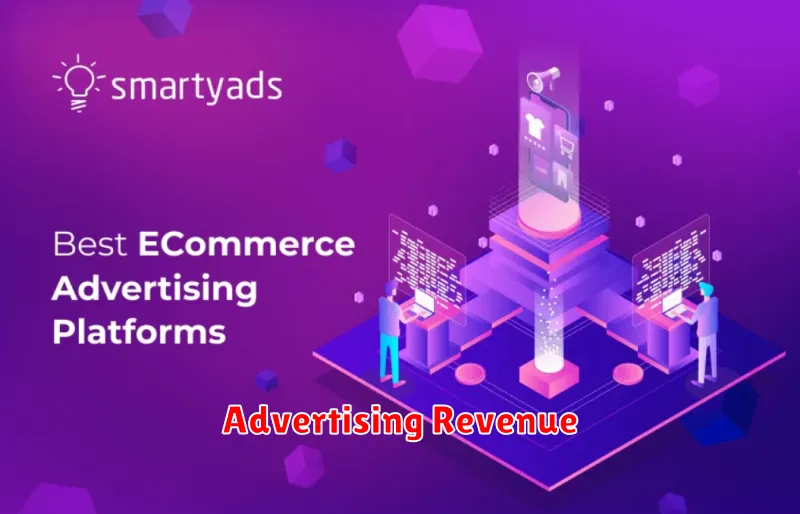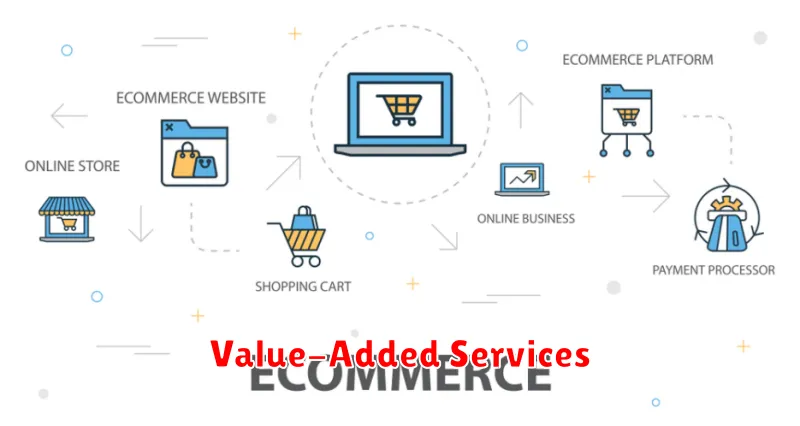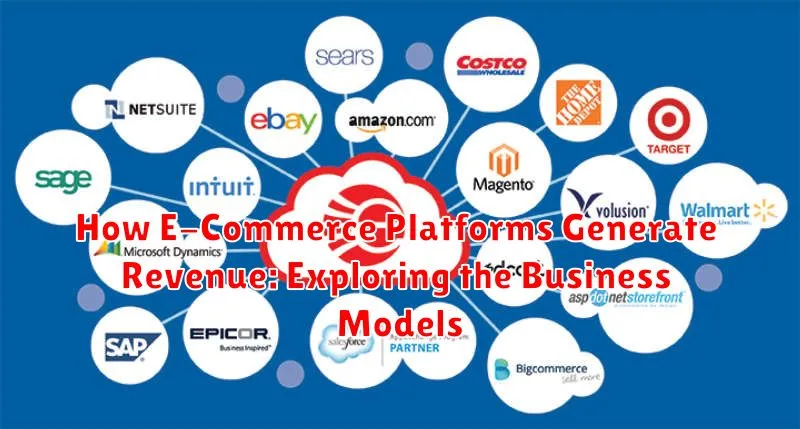In today’s digital landscape, e-commerce platforms have revolutionized how businesses operate and consumers shop. Understanding how these platforms generate revenue is crucial for entrepreneurs, investors, and anyone interested in the intricacies of the online marketplace. This article explores the various business models employed by e-commerce platforms, shedding light on the mechanisms that drive their profitability and contribute to the ever-expanding world of online commerce. We will delve into the diverse revenue streams utilized by these platforms, ranging from transaction fees and subscription models to advertising and data analytics services. By examining these different approaches, we aim to provide a comprehensive overview of how e-commerce platforms sustain themselves and contribute to the dynamic digital economy.
From established giants like Amazon and Alibaba to niche marketplaces catering to specific industries, the e-commerce ecosystem encompasses a wide spectrum of platforms, each with its unique revenue generation strategy. This article will provide a detailed examination of these strategies, highlighting the key revenue models used in the e-commerce landscape. By understanding how these platforms generate revenue, readers will gain valuable insights into the economic forces shaping the future of online retail, the challenges faced by e-commerce businesses, and the innovative solutions they employ to thrive in a competitive market. Whether you’re an aspiring entrepreneur, a seasoned investor, or simply curious about the inner workings of online marketplaces, this exploration of e-commerce revenue models will provide a valuable foundation for understanding this rapidly evolving industry.
The Different Types of E-Commerce Platforms
E-commerce platforms vary significantly in their structure and functionality, catering to diverse business needs and seller profiles. Understanding these different types is crucial for grasping how they generate revenue.
Open-source platforms offer high levels of customization and control, but require technical expertise for setup and maintenance. They are often preferred by larger businesses with dedicated development teams.
SaaS (Software-as-a-Service) platforms provide user-friendly interfaces and require minimal technical setup. They are popular among small and medium-sized businesses due to their ease of use and scalability.
Marketplace platforms connect multiple sellers with a large customer base. These platforms handle marketing and payment processing, simplifying sales for individual vendors. Examples include giants like Amazon and eBay.
Finally, headless commerce platforms offer flexibility by separating the front-end and back-end of the platform. This allows businesses to customize the customer experience while leveraging the robust back-end functionality of the platform.
Subscription Fees
Subscription fees represent a recurring revenue stream for many e-commerce platforms. This model involves charging merchants a regular fee, often monthly or annually, for access to the platform’s features and services. The subscription cost can vary based on factors such as the platform’s size, the tools and services offered, and the merchant’s sales volume or required bandwidth.
This model offers predictability for both the platform and the merchant. The platform receives a stable income, while the merchant knows their platform costs upfront. Subscription tiers are common, allowing merchants to choose a plan that aligns with their business needs and budget. A basic plan may offer essential features, while premium subscriptions often include advanced analytics, dedicated support, and increased selling capacity.
Transaction Fees
Transaction fees represent a common revenue stream for many e-commerce platforms. Essentially, the platform charges a small fee for each transaction processed through its system. This fee can be a fixed amount per transaction or a percentage of the total transaction value.
This model is particularly prevalent with platforms that facilitate payments or act as intermediaries between buyers and sellers. The transaction fee covers the costs associated with processing payments securely and efficiently, including things like credit card processing fees and security measures.
The advantage of this model for the platform is the direct correlation between transaction volume and revenue. Higher sales volume translates directly into increased revenue from transaction fees.
Commission on Sales
This revenue model focuses on taking a percentage of each sale facilitated through the platform. Commission rates vary based on factors such as the product category, the seller’s sales volume, and the platform’s pricing structure. It incentivizes the platform to support sellers in maximizing their sales, as the platform’s revenue is directly tied to the seller’s success.
Typically, the commission is deducted from the seller’s payout after a successful transaction. This model is particularly common in marketplaces where multiple third-party sellers offer products through a single platform. It provides a straightforward and scalable revenue stream for the e-commerce platform.
Key Considerations:
- Competitive Commission Rates: Platforms must offer competitive rates to attract and retain sellers.
- Transparent Fee Structure: Clearly outlining the commission structure builds trust with sellers.
- Value-Added Services: Offering services like marketing support or fulfillment options can justify higher commission rates.
Advertising Revenue

Advertising constitutes a significant revenue stream for many e-commerce platforms. Platforms can leverage their substantial user base and traffic to offer valuable advertising space to sellers and other businesses.
Several advertising models are commonly employed. Cost-per-click (CPC) advertising charges advertisers each time a user clicks on their ad. Cost-per-thousand impressions (CPM), also known as cost per mille, charges based on the number of times an ad is displayed, regardless of clicks. Sponsored product listings allow sellers to pay for prominent placement of their products in search results or category pages.
The effectiveness of advertising on e-commerce platforms is often enhanced by the platform’s ability to target specific demographics and user interests based on browsing history and purchase behavior. This targeted approach allows advertisers to reach a more relevant audience, increasing the likelihood of conversion and maximizing return on investment.
Payment Processing Fees
A primary revenue stream for e-commerce platforms comes from payment processing fees. Every time a transaction occurs on the platform, a small percentage of the sale is charged to the seller. This fee covers the costs associated with processing the payment, including transaction security, fraud prevention, and transfer of funds.
These fees can be structured in various ways. A common model is a percentage-based fee, where the platform takes a fixed percentage of each transaction. For example, a platform might charge 2.9% + $0.30 per transaction. This means a seller making a $10 sale would pay $0.59 in processing fees.
The fee structure often varies depending on the payment method used. Credit card transactions typically incur higher fees than other methods like bank transfers or platform-specific wallets. This difference is due to the complex infrastructure and security protocols involved in credit card processing. Negotiating lower processing fees can be possible for high-volume sellers, giving them a competitive edge in pricing.
Value-Added Services

Beyond core transaction fees, e-commerce platforms offer a range of value-added services designed to enhance seller capabilities and boost sales. These services often generate substantial revenue streams for the platforms while providing valuable tools for businesses.
Fulfillment services are a prime example. Platforms may handle warehousing, packing, and shipping, streamlining logistics for sellers in exchange for a fee. This allows businesses, particularly smaller ones, to avoid the complexities of managing their own logistics network.
Marketing and advertising services are another key area. Platforms can offer targeted advertising options, sponsored product placements, and other promotional tools to help sellers reach a wider audience. These premium services often come at a cost, but they provide significant value by driving visibility and potential sales.
Subscription-based services, such as enhanced analytics dashboards, premium customer support, or dedicated account management, also contribute to platform revenue. These services provide specialized support and tools that can give sellers a competitive edge.
Data Monetization
While not as direct as transaction fees, data monetization is a growing revenue stream for e-commerce platforms. By aggregating and analyzing vast amounts of user data, platforms can glean valuable insights into consumer behavior, preferences, and trends. This information can be monetized in several ways.
Market research and analytics: Aggregated and anonymized data can be sold to market research firms, brands, and other businesses seeking to understand consumer behavior. This allows them to refine their marketing strategies, product development, and target specific demographics effectively.
Targeted advertising: E-commerce platforms can leverage user data to offer highly targeted advertising opportunities to sellers. By understanding user demographics, browsing history, and purchase patterns, platforms can deliver ads that are more relevant and likely to convert, commanding higher advertising rates. This personalized advertising approach benefits both the platform and the sellers.
Strategic partnerships: Platforms may form strategic partnerships with other businesses to share anonymized data insights. This could involve collaborating with complementary services or sharing data to enhance logistics, supply chain management, or other operational efficiencies.
The Future of E-Commerce Monetization
The e-commerce landscape is constantly evolving, and so are its monetization strategies. Several key trends are shaping the future of how these platforms generate revenue.
Artificial Intelligence (AI) will play a crucial role. Personalized recommendations and dynamic pricing are becoming increasingly sophisticated, allowing platforms to optimize sales and increase average order values. AI-powered chatbots and virtual assistants also enhance customer service and streamline the shopping experience, potentially leading to higher conversion rates and customer loyalty which translates into increased revenue.
The rise of Augmented Reality (AR) and Virtual Reality (VR) offers immersive shopping experiences. Trying on clothes virtually or visualizing furniture in your home before purchasing could significantly reduce return rates and boost sales. These technologies open doors for new monetization opportunities through virtual showrooms and interactive advertisements.
Blockchain technology has the potential to revolutionize supply chain management and increase transparency, building consumer trust. This can lead to greater customer loyalty and potentially higher sales. Further, blockchain can facilitate secure and transparent payment systems, reducing transaction costs and potentially opening up new micropayment models.
Finally, the metaverse represents a paradigm shift in e-commerce. Virtual storefronts and immersive shopping experiences within these digital worlds are creating entirely new revenue streams for platforms. The integration of digital ownership and virtual goods further expands the potential for monetization through virtual real estate sales, in-world advertising, and sales of digital assets.

